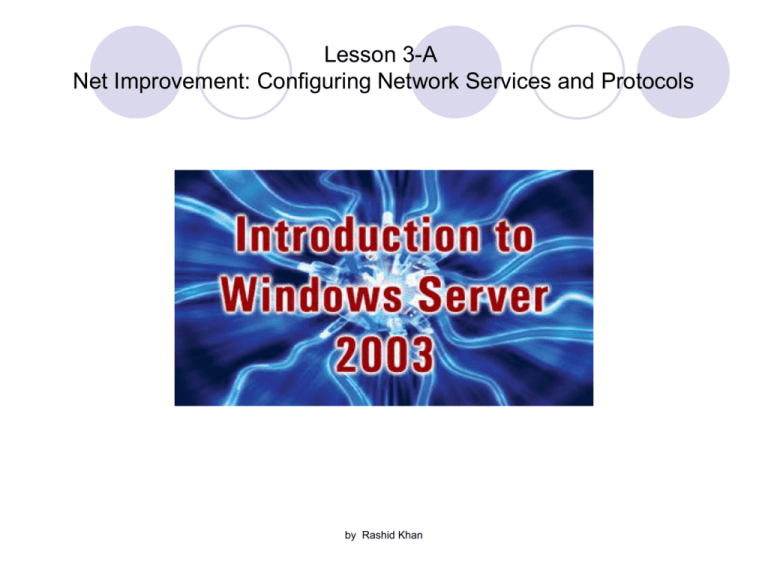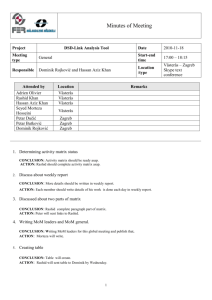Chap 3
advertisement

Lesson 3-A Net Improvement: Configuring Network Services and Protocols by Rashid Khan Overview Understand basic TCP/IP concepts. Configure TCP/IP. Set up DHCP. Set up DNS and WINS. by Rashid Khan Understand Basic TCP/IP Concepts Transmission Control Protocol/Internet Protocol (TCP/IP): Is the most common protocol for handling network communications on Microsoft networks. Is also the preferred protocol for the Internet. by Rashid Khan Understand Basic TCP/IP Concepts Addressing: Computer networks require unique addresses for each connected device. The TCP/IP protocol suite implements IP addresses that provide a unique identity to devices on the network. by Rashid Khan Understand Basic TCP/IP Concepts Unique IP addresses are necessary for communication between network devices. by Rashid Khan Understand Basic TCP/IP Concepts Addressing (continued): Subnet masks. Public IP addresses. Private IP addresses. by Rashid Khan Subnet Masks A subnet mask indicates the part of an IP address that refers to the network and the part of an IP address that refers to devices (hosts) on the network. Masking a smaller segment of the IP address allows few networks with more hosts. Masking a larger segment of the IP address allows more networks with few hosts. by Rashid Khan Subnet Masks Subnetting: Custom subnet masks can be used to subdivide a single range of IP addresses into two or more smaller ranges. Network administrators can decide to separate segments of the network to enhance security, ease management, and enhance performance. by Rashid Khan Public IP Addresses The Internet service provider (ISP) provides Internet connectivity to organizations, and handles the actual assigning of IP addresses. ISPs get their allocation of IP addresses from a Local (LIR), National (NIR), or Regional Internet Registry (RIR). IP addresses for public networks are distributed using a system of three primary classes, known as classes A, B, and C. by Rashid Khan Public IP Addresses Address Ranges for Class-Based IP Addresses by Rashid Khan Public IP Addresses The Classless Inter-Domain Routing (CIDR) is an addressing scheme for allocating IP addresses. It uses variable-length subnet masks, which helps control the number of addresses assigned to any particular network. by Rashid Khan Private IP Addresses The Internet Assigned Numbered Authority (IANA) reserves special ranges of IP addresses for use within private networks. Such addresses are recognized as private addresses by networking hardware and software. Such networks connect to other external networks through routers that support Network Address Translation (NAT). by Rashid Khan Configure TCP/IP Dynamic and static IP addressing. Changing connection properties. by Rashid Khan Private IP Addresses Acceptable Ranges for Private IP Addresses by Rashid Khan Dynamic and Static IP Addressing Dynamic IP addressing: A Dynamic Host Configuration Protocol (DHCP) server provides a dynamic IP address to each device as it connects to the network. A dynamic IP address can often change, each time a connection to the network is established. by Rashid Khan Dynamic and Static IP Addressing Static IP addressing: A static IP address does not change. Static addresses need to be set manually. by Rashid Khan Change Connection Properties The Local Area Connection Properties dialog box by Rashid Khan Change Connection Properties The Internet Protocol (TCP/IP) Properties dialog box by Rashid Khan Change Connection Properties The Internet Protocol (TCP/IP) Properties by Rashid Khan Change Connection Properties Specifying an IP by Rashid Khan Address Change Connection Properties Specifying an IP Address by Rashid Khan Set Up DHCP DHCP benefits. Configuring DHCP. by Rashid Khan DHCP Benefits DHCP offers the following benefits: Windows accepts an incorrect TCP/IP address or a subnet mask entry, as long as the typed format resembles an actual address or a subnet mask. DHCP ensures that each address is unique. by Rashid Khan Configuring DHCP At least one server on the network must be configured as a DHCP server. DHCP sever is not installed with Windows Server 2003. DHCP manages IP addresses by issuing a lease to client computers for a particular address. The address is taken from a pool of addresses called the scope. by Rashid Khan Configuring DHCP The scope >> a range of IP addresses that are valid for the network to which the DHCP server is connected. The lease issued to clients is valid for a limited time for a particular IP address. Prior to the expiration date, the client can request for a renewal. If the lease expires, clients have to request for a new IP address from the DHCP server. by Rashid Khan Configuring DHCP The New Scope Wizard offers the following settings to add a new DHCP scope: Name and description. IP Address range and subnet mask. Excluded IP addresses. Lease duration. Default gateway. Domain Name System (DNS) and Windows Internet Name Service (WINS) settings. by Rashid Khan Configuring DHCP by Rashid Khan Adding a Scope Configuring DHCP Specifying an byIPRashid Address Range Khan Configuring DHCP Adding Exclusions by Rashid Khan Configuring DHCP Configuring DHCP Options by Rashid Khan Configuring DHCP Contents of the Scope by Rashid Khan Set Up DNS and WINS DNS and WINS can translate Internet domain names to IP addresses. This translation process is called name resolution. by Rashid Khan Set Up DNS and WINS Difference between DNS and WINS. Configuring DNS. Client configuration. by Rashid Khan Set Up DNS and WINS The Windows Components Wizard by Rashid Khan Set Up DNS and WINS Networking Services by Rashid Khan Set Up DNS and WINS Completing the Windows Component Wizard by Rashid Khan Difference between DNS and WINS DNS: DNS should be installed on most Windows Server 2003 networks. DNS resolves the IP host name to the IP address. However, operating systems such as Windows NT and Windows 98 communicate over networks using NetBIOS names. Network Basic Input/Output System (NetBIOS) names need the services of WINS to be resolved into IP addresses. by Rashid Khan Configure DNS Lookup zones Zone name by Rashid Khan Lookup Zones A forward lookup zone sends name resolution requests for names outside a domain to an external DNS server. The internal DNS server handles all requests for internal name resolution. The DNS server processes each name resolution request and determines whether or not it can resolve the name. If the DNS server cannot resolve the name, it queries known external DNS servers. by Rashid Khan Zone Name A zone name: Identifies the domain or portion of a domain for which a DNS server is responsible. Is used by the DNS server to determine which name requests are internal and which are not. by Rashid Khan Client Configuration Clients connected to the network must be properly configured to work with DHCP. On Windows XP and Windows 2000, the TCP/IP settings can be configured to obtain the IP address and the DNS server address automatically. On older operating systems, the WINS server needs to be configured to use DHCP for WINS resolution. by Rashid Khan Client Configuration Configuring a DNS Server by Rashid Khan Client Configuration Selecting a Configuration Action by Rashid Khan Client Configuration Selecting a Primary Server Location by Rashid Khan Client Configuration Specifying a Zone Name by Rashid Khan Client Configuration Setting Dynamic Updates by Rashid Khan Client Configuration Forwarders by Rashid Khan Client Configuration The DNS Tab in the Advanced TCP/IP Settings by Rashid Khan Client Configuration Rashid Khan Configuringby Scope Options Summary The TCP/IP protocol suite is the preferred protocol for networks and the Internet. It distinguishes each device on a network by implementing IP addresses. TCP/IP can be configured statically or dynamically. DHCP servers can reuse IP addresses that are not currently in use. DNS and WINS can resolve Internet domain names to IP addresses. by Rashid Khan





